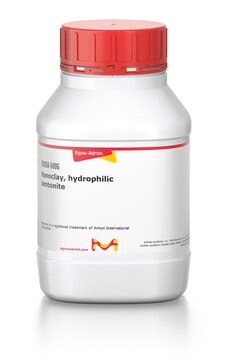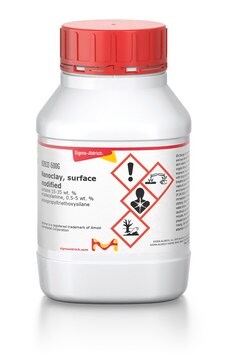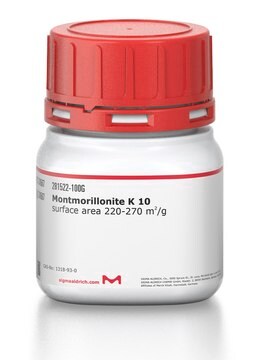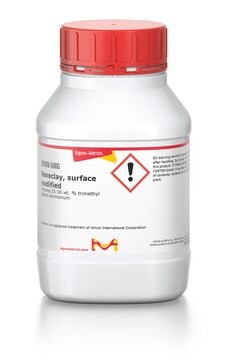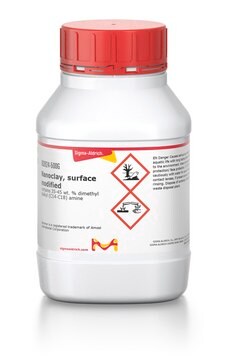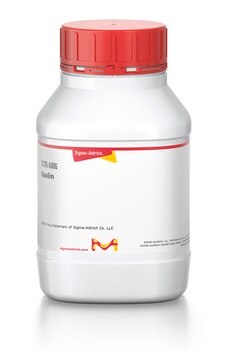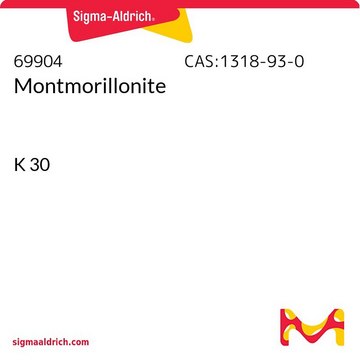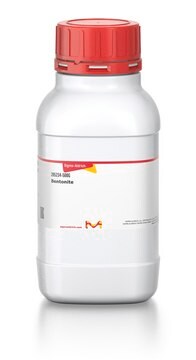685445
Halloysite Nanoclay
Sinónimos:
Kaolin clay
About This Item
Productos recomendados
Formulario
nanopowder
Nivel de calidad
diám. × L
30-70 nm × 1-3 μm , nanotube
superficie
64 m2/g
color
75-96, Hunter Brightness
índice de refracción
n20/D 1.54
tamaño de poro
1.26-1.34 mL/g pore volume
capacidad
8.0 meq/g cation exchange capacity
densidad
2.53 (true specific gravity)
cadena SMILES
O.O.O[Si](O)(O[Al]=O)O[Si](O)(O)O[Al]=O
InChI
1S/2Al.H4O7Si2.2H2O.2O/c;;1-8(2,3)7-9(4,5)6;;;;/h;;1-2,4-5H;2*1H2;;/q2*+1;-2;;;;
Clave InChI
HEFIDAICLOZRRO-UHFFFAOYSA-N
Descripción general
Similar to montmorillonite, halloysite consists of two layers of aluminosilicate in 1:1 Al:Si ratio. Significant improvements in thermal, mechanical properties have been reported on addition of halloysite nanotubes in polymer composites.
Aplicación
Isotactic propylene-halloysite nanocomposites.
Alloy composites by electroless/ autocatalytic deposition.
Poly(butylene terephthalate) (PBT) composites.
Zinc–halloysite nanotube (HNT) composite coatings.
Halloysite nanotube–hydroxyapatite–hyaluronic acid films.
Halloysite combined with polyamide, polypropylene, poly(ε-caprolactone) and fluroelastomers.
Its tube like morphology, high aspect ratio, and low percolation enables interesting applications as reinforcements in nanocomposites.
Información legal
Código de clase de almacenamiento
11 - Combustible Solids
Clase de riesgo para el agua (WGK)
nwg
Punto de inflamabilidad (°F)
Not applicable
Punto de inflamabilidad (°C)
Not applicable
Equipo de protección personal
Eyeshields, Gloves, type N95 (US)
Elija entre una de las versiones más recientes:
¿Ya tiene este producto?
Encuentre la documentación para los productos que ha comprado recientemente en la Biblioteca de documentos.
Los clientes también vieron
Artículos
Halloysite Nanotubes in Nanomaterials Research. Halloysite, a naturally occurring aluminosilicate nanotube, has been undeservedly forgotten.
Nanoclays are nanoparticles of layered mineral silicates. Montmorillonite, bentonite, and halloysite nanoclays and organoclays are used in polymer-clay nanocomposites, as rheology modifiers, and drug delivery carriers.
Graphene is a one-atomic-layer thick two-dimensional material made of carbon atoms arranged in a honeycomb structure. Its fascinating electrical, optical, and mechanical properties ignited enormous interdisciplinary interest from the physics, chemistry, and materials science fields.
Nuestro equipo de científicos tiene experiencia en todas las áreas de investigación: Ciencias de la vida, Ciencia de los materiales, Síntesis química, Cromatografía, Analítica y muchas otras.
Póngase en contacto con el Servicio técnico